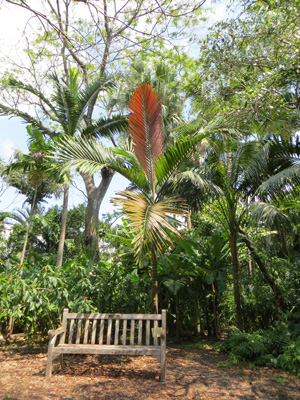Palms that break the rules

By SARA EDELMAN
As published in the Miami Herald, 10/4/14.
Most plant lovers are knowledgeable about palm habit. It is uniform — a trunk with one crown of green, folded leaves and flowers borne below or within the crown. This most common growth habit gives the best support, with the greatest chance of survival for a majority of palm species.
Just like the real world, certain palms follow the rules scrupulously, and others see how far they can bend them.
The palm species that follow this protocol explicitly are the teachers’ pets; they follow all directions unconditionally. So many palms fall under this category of straight-A student: royal, coconut and Christmas palms. The Montgomery palm (Veitchia montgomeryana) is a wonderful grower, despite its lack of creativity and willingness to follow rules blindly. It will grow quickly (for a palm) when planted in full sun with lots of water.
However, there are just as many palms who follow a different creed: Rules are meant to be broken. While following the rules is usually a necessity, some palms love to break them! Let’s plant these rebellious palms for the rebel in us all.
The easiest derivation from the rule is a many-stemmed trunk. These palms still make the highest marks but don’t quite walk the line. They get to class just as the tardy bell rings. Saw palmetto, Macarthur and lady palms are rule benders.
Ptychosperma schefferi, a close relative of the Macarthur palm, hasn’t decided how closely it wants to follow the rulebooks. Its trunk can be either solitary or multi-stemmed. Although indecisive in its habit, it is consistently a good choice for southern Florida, growing well in our alkaline soils with high cold tolerance.
Some of the biggest rule breakers are the Hyphaene palms (Hyphaene sp.). They stray from the first palm rule: one crown per head. These palms branch at the growth bud creating two equally sized crowns. While this architecture should be unstable, Hyphaene palms dominate the desert. If you’re going to plant a Hyphaene keep it high, dry and in the sun.
The mazari palm (Nannorhops ritchiana) takes a page from Hyphaene’s playbook and branches aerially as well. However, the mazari takes it one step further. One crown is vegetative, producing leaves only, while the other produces flowers and dies. The vegetative crown splits again and the pattern continues. Mazari palms are not as readily available but are incredibly hardy. If you manage to get your hands on one, get ready to have a rebel palm that will have your neighbors talking.
The flame thrower palm (Chambeyronia macrocarpa) isn’t an outright rebel, preferring merely to push the limits. She dyes her hair and the result is magnificent. Instead of having a typical green crown, the newest leaf is bright red. Unlike the Hyphaene and mazari palms, the flame thrower palm can be found in most nurseries. This palm can grow in full sun or partial shade. Simply plant it in a moist but well-drained area and watch for that defiant red leaf.

CENTER OF ATTENTION: Chambeyronia macrocarpa is appropriately named the flame thrower palm as its newest leaf is a magnificent read. Sara Edelman/FTBG.
The previous palms play it safe and reproduce many times to ensure future generations. The Corypha palm (Corypha sp.) is a gambler. The Coryphapalms do not hedge their bets — they go all in. They produce a copious amount of flowers one time above their crown of leaves and then die. In their one reproductive event they can produce millions of flowers and thousands of seeds. In the wild these palms grow along waterways and floodplains in grasslands. They have low nutrient requirements and do well in our Florida soils. Plant them in full sun and moist soil.

Corypha palms gamble their reproductive success and produce flowers one time and then die. Sara Edelman/FTBG.
The shiftiest of the bunch is the nonconformist who breaks rules right under your nose. Their growth habit is defiant, yet so sneaky we don’t even realize. The title of slyest rule breaker belongs to our own Florida native, the dwarf palmetto (Sabal minor). At first glance, this palm appears to be little and seemingly insignificant. While its close relative Sabal palmetto grows a tall trunk, the dwarf palmetto counters and keeps its stem underground. Don’t let its short stature fool you; it has a full-grown stem that is simply buried underground. Plant this palm in full sun, with dry soil and a large area for the underground stem to grow.

Sabal minor, the dwarf palmetto, grows its stem underground to protect its trunk from fire. Sara Edelman/FTBG.
Palms that exhibit strange growth live in areas not conducive to typical palm growth. Underground stems protect a delicate trunk from fire, and clumping is advantageous in wetlands. Their seemingly rebellious growth habits make them stronger. These variations of the typical palm decorum also make them hardier ornamentals. Any of these palms would be a beautiful (and rebellious) addition to your backyard.
